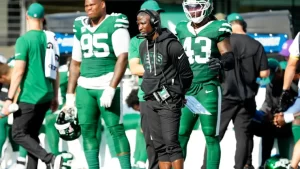Levi’s, the iconic brand known for its blue jeans, is struggling to keep up with the current trend of denim becoming fashionable among young consumers. Despite the popularity of denim, it seems that Levi’s is not benefiting much from this trend. For instance, even though 19-year-old Maryland resident Griffin Brown wears Levi’s jeans with almost every outfit, he can’t bring himself to buy a new pair at full price. Instead, he opts for thrifting, owning three pairs of thrifted Levi’s jeans and one pair obtained through a trade.
This situation highlights the challenges that Levi’s is facing in capturing the attention and loyalty of younger consumers. While denim is a hot trend at the moment, other brands seem to be taking the lead in capitalizing on this trend. As a result, Levi’s finds itself trying to catch up to the competition and win back the hearts of its target audience.
To understand why Levi’s is struggling, it is important to examine the current landscape of the denim market and the preferences of young consumers. Research shows that younger shoppers are drawn to brands that offer a unique and personalized shopping experience, and Levi’s may be falling short in this aspect. Additionally, the rise of sustainable fashion and the desire for ethical and eco-friendly clothing choices have become important factors for younger consumers when making purchasing decisions. Levi’s, therefore, needs to adapt to these preferences and showcase its commitment to sustainability if it wants to regain its relevance in the denim market.
One example of a brand that successfully tapped into the denim trend and captured the attention of young consumers is Everlane. Everlane has gained a loyal following by offering high-quality denim at transparent and affordable prices. They also prioritize sustainable practices and provide detailed information about their supply chain, which resonates with socially-conscious consumers.
In conclusion, even as denim experiences a moment of popularity among young consumers, Levi’s finds itself lagging behind the competition. It must adapt to the changing preferences of its target audience, including offering personalized experiences and showcasing its commitment to sustainability. By doing so, Levi’s can regain its position as the go-to brand for fashionable and ethical denim choices. The challenge is to transform the iconic brand’s image and keep up with the ever-evolving trends of the fashion industry. Will Levi’s be able to catch up and reclaim its throne in the denim market? Only time will tell.
Prefer to listen? No problem! We’ve created an audio version for your convenience. Press play and relax while you absorb the information.











